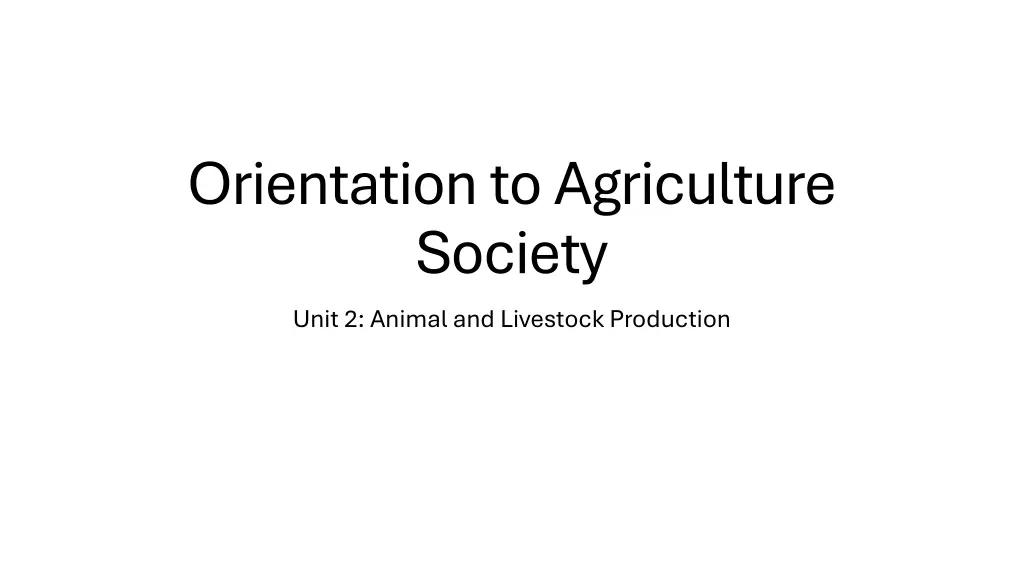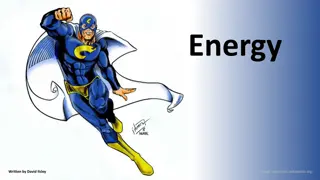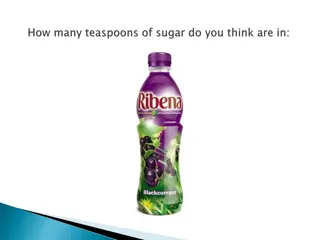
Animal Agriculture and Livestock Production Essentials
Explore key terminology and production practices in animal agriculture, including cattle, pigs, goats, sheep, and poultry. Delve into the diverse aspects of beef production in Oklahoma and its significant contribution to the state's economy.
Download Presentation

Please find below an Image/Link to download the presentation.
The content on the website is provided AS IS for your information and personal use only. It may not be sold, licensed, or shared on other websites without obtaining consent from the author. If you encounter any issues during the download, it is possible that the publisher has removed the file from their server.
You are allowed to download the files provided on this website for personal or commercial use, subject to the condition that they are used lawfully. All files are the property of their respective owners.
The content on the website is provided AS IS for your information and personal use only. It may not be sold, licensed, or shared on other websites without obtaining consent from the author.
E N D
Presentation Transcript
Orientation to Agriculture Society Unit 2: Animal and Livestock Production
Animal Agriculture Unit 2 Lesson 1
Lesson 1 Objectives Define terminology common in livestock production Describe major animal agricultural production in Oklahoma Explore feeding strategies common to livestock production
Cattle Terminology Calving Calving Act of parturition for cattle Calf Calf Young bovine animal Steer Steer Castrated male Heifer Heifer Immature female Bull Bull Mature, intact male Cow Cow Mature female who has calved Beef Beef Meat derived from cattle
Pig Terms Farrowing Farrowing Act of parturition for pigs Piglet Piglet Young pig Barrow Barrow Castrated male Gilt Gilt Immature female Boar Boar Mature, intact male Sow Sow Mature female who has calved Pork Pork Meat derived from pigs
Goat Terms Kidding Kidding Act of parturition for goats Kid Kid Young goat Wether Wether Castrated male Doe Doe Female over a year Buck Buck Mature, intact male Chevon Chevon Meat derived from goats
Sheep Terms Lambing Lambing Act of parturition for sheep Ewe Ewe Female sheep Wether Wether Castrated male Ram Ram Mature, intact male Lamb Lamb Young sheep Mutton Mutton Meat derived from sheep
Poultry Terms Rooster Rooster Adult male chicken Hen Hen Adult female chicken Cockerel Cockerel Young male chicken Broiler Broiler Chicken raised for meat Pullet Pullet Young female that hasn't started laying eggs
Beef Production in Oklahoma Production in Oklahoma Nationally, Oklahoma ranks Top 5 Most producers are Cow Where a calf is produced and eventually sold or used Cattle production in Oklahoma is found in the entire state Oklahoma's beef industry contributed $2.7 billion Oklahoma's economy Top 5 for beef cattle numbers Cow- -Calf producers Calf producers 2.7 billion to
Pork Production in Oklahoma Production in Oklahoma Oklahoma is a top 10 Large Large commercial hog farms contribute the most to production Key pork-producing areas include the panhandle of northeast northeast Oklahoma Oklahoma. Pork products from Oklahoma are sold across the US and globally globally top 10 pork-producing state state. panhandle and parts
Poultry Production in Oklahoma Poultry is one of the most important livestock industries most important livestock industries in the state. Concentrated in eastern Oklahoma eastern Oklahoma, especially Muskogee, McCurtain, and Le Flore counties. Primarily raised under a system called contract farming like Tyson Tyson Focus on broilers broilers (meat chickens) and layers contract farming with companies layers (egg production)
Dairy Production in Oklahoma Dairy cows produce milk Can be turned into products like cheese, yogurt, and butter There are dairy farms throughout Oklahoma Farms may be family family- -owned owned or part of larger corporations. Though smaller than beef or poultry, large companies like Hiland and Braums Braums have large presences in Oklahoma milk cheese, yogurt, and butter. Hiland Oklahoma
Sheep and Goat Production Production in Oklahoma for meat isn't as prevalent as the other major livestock species Sheep and goats are most common in small Sheep Sheep and Goat Goat operations for showing Both animals are used in ethnic markets ethnic markets and specialty Goats Raised for meat (chevon) meat (chevon) and milk milk Goat milk has increased increased in popularity in recent years as an alternative traditional dairy products Goats are used for brush control brush control and land management Sheep Raised for meat meat and fiber fiber small- -scale farms scale farms and in Club Club specialty meat programs alternative to land management
Feeding Livestock Livestock need to be fed balanced vitamins, and minerals. Proper Proper nutritionhelps animals grow and stay healthy, which is important for livestock production Common Feed Ingredients: Hay Hay Dried grass grass or legumes (like alfalfa alfalfa) Provides fiber fiber, energy, protein Sheep, Goats, Cattle Corn & Soybeans Corn & Soybeans Provide energy energy and protein Common in pig pig and poultry poultry diets. Cattle are fed grains like corn in the finishing finishing stage balanced diet of energy, protein,
Feeding Livestock Common Feed Ingredients: Silage Silage Fermented green feed (usually chopped corn plants) Rich in nutrients nutrients for cattle. Mineral Supplements Mineral Supplements Provide essential nutrients like calcium Water Water Livestock need clean water clean water every day to stay healthy. Cattle drink 1 gallon of water for every 100lbs calcium, phosphorus, salt.
Livestock Feeding Strategies Rations Rations Different animals require different rations A newborn newborn animal needs different nutrition than a mature The purpose purpose of an animal impacts its ration as well Milk Milk vs Meat Meat Reproduction Reproduction vs companionship companionship vs sport Animal nutritionists Animal nutritionists will create rations decided what what and how much how much to feed Automated feeders Automated feeders and feed trucks feed trucks are often used on large farms. rations mature animal sport rations to help producers
Livestock Feeding Strategies Cattle (Beef & Dairy) Cattle (Beef & Dairy) Eat mostly forages May get grain Cattle can be given supplements Dairy cows Dairy cows need high-energy diets to produce milk Corn silage, soybean meal, and minerals Pigs Pigs Ground corn Ground corn and soybeans soybeans are staples Pigs need high high- -protein protein feed rations to grow quickly Hogs in commercial operations are fed using automatic feeders barns forages like hay grain in feedlots for faster weight gain supplements to ensure they are healthy hay, pasture pasture, and silage silage milk quickly automatic feeders in indoor
Livestock Feeding Strategies Poultry Poultry Rations are a combination of corn, soybean, vitamins, and minerals Typically shaped into pellets pellets or crumbles Depending on the purpose of the poultry animal, they could get fed differently Broilers Broilers (meat chickens) get feed to grow fast Layers Layers (egg hens) get extra calcium calcium to form strong eggshells Goats Goats Goats love variety in their feed Eat hay, pasture pasture, leaves, and browse Need grain grain or pelleted pelleted feed for extra energy when milking or growing Sheep Sheep Hay, Hay, silage, and pasture pasture Pregnant or lactating ewes may get some grain grain
Lesson 1 Review What livestock animals are most common in Oklahoma? Name and describe some of the different livestock terms used. Which livestock animal contributes the most to Oklahoma GDP? How is feeding livestock different among the different major livestock species in Oklahoma?
Veterinary Science Basics and Health Care Unit 2 Lesson 2
Lesson 2 Objectives Describe the purpose of veterinarians in agriculture Compare and contrast different types of veterinarians Describe common biosecurity practices to prevent disease in animal agriculture
Veterinarians Veterinarians are doctors for animals Different specialties: Large Large Animal Veterinarian Cattle, sheep, goats, pigs, horses Small Small Animal Veterinarian Dogs, cats, birds, rabbits Exotic Exotic Animal Veterinarian Birds, reptiles Research Dermatology Emergency and Critical Care
Large Animal Veterinarians Work at farms, vet clinics, feedlots, Care for livestock animals livestock animals like cattle, pigs, goats, sheep, and horses. Sometimes make farm calls farm calls They check and treat illnesses, injuries illnesses, injuries Make sure animals are healthy healthy to produce food Common tasks: Vaccinating animals Checking pregnant livestock and helping with birthing Treating infections, wounds, or injuries Advising farmers on nutrition and biosecurity food safely.
Small Animal Veterinarians They work in clinics, Mostly care for pets Focus on pet health and wellness pet health and wellness Common tasks: Giving check-ups and vaccines Performing surgeries and dental care Diagnosing illnesses Advising owners on proper food, exercise, and care These vets help keep animals healthy disease, and help with responsible clinics, animal hospitals, or shelters. pets like dogs, cats, rabbits, and birds. healthy, prevent the spread of responsible pet ownership.
Biosecurity in Animal Agriculture What is Biosecurity? Prevents costly disease outbreaks Protects animal welfare and farm income Helps keep food safe safe for consumers All actions actions to protect animals from diseases Can be rules rules or regulations Helps keep livestock healthy, prevents disease outbreaks, and protects the food supply Can include: Sanitation Vaccination Quarantine PPE outbreaks income diseases and virus virus
Common Biosecurity Practices Limiting foot traffic foot traffic Limiting visitors Controlling access to farms Clean and disinfect any potential visitors Cleaning and disinfecting disinfecting Equipment, vehicles, and footwear Quarantining Quarantining Separate Separate new or sick animals before introducing them to the herd/flock Using protective clothing (PPE) protective clothing (PPE) like gloves and boots Proper disposal disposal of dead animals and waste Regular vaccinations vaccinations and health checks visitors visitors
Lesson 2 Review What is the difference between a small animal veterinarian and a large animal veterinarian? What are some common responsibilities of large and small animal veterinarians? How can farmers use biosecurity? What is biosecurity and how could it differ between animal species?
Small and Companion Animals Unit 2 Lesson 3
Lesson 3 Objectives Define companion and working animals Explain important factors when caring for companion animals Compare and contrast types of companion animals Explore the working roles of working animals
More Than Livestock Most people are familiar with animals as non Non-livestock animals are domesticated agricultural agricultural purposes These can include companion animals and working animals non- -livestock animals livestock animals domesticated animals not raised for
Companion Animals Kept for companionship companionship, recreation Common animals include: dogs, cats These animals live inside or outside people s homes and become part of the family Pet owners care for companion animals by providing food, shelter, health care, and love shelter, health care, and love In return, companion animals can help reduce stress improve people s mental health recreation, or emotional cats, rabbits, birds, fish, reptiles emotional support support reptiles food, stress and loneliness loneliness and
Caring for Companion Animals Food Food and Water A nutritious diet that meets needs Fresh water replaced and refilled daily Shelter Shelter A safe and comfortable place to live and rest This varies on species and breed of animal Exercise and Play Exercise and Play Daily physical movement and interaction to stay fit Could include walking the dog, cat trees, or enrichment for other animals Water
Caring for Companion Animals Grooming Grooming Bathing, brushing, and trimming nails Vet Care Vet Care Regular check-ups, vaccines Spaying Spaying or neutering neutering is important in managing populations Loving Care Loving Care Positive social time social time with people and/or other pets Many animals want to please theirowner Care includes training,companionship trimming nails when needed vaccines, and treatment when sick
Dogs Feeding Feed dog food based on size Don't feed human food human food can cause health issues Exercise Exercise Going for walks walks, playtime, and mental stimulation Training Basic commands commands like sit and stay, potty training Grooming Varies by breed breed Some longhaired longhaired breeds require daily brushing Health Regular heartworm heartworm prevention, flea/tick care, annual veterinarian visits Because they are pack animals, dogs need lots of time and interaction size, age, health needs, activities activities stimulation are essential potty training, social skills brushing, some need bathing more veterinarian visits lots of time and interaction
Cats Feeding Feeding Cat food, fresh water Litter Box Litter Box Cats need a private Litter boxes need to be cleaned regularly Should be placed in a quiet spot in the house Play & Enrichment Play & Enrichment Toys, cat trees, scratching posts, climbing space Grooming Grooming Most groom themselves, but some need brushing Health Health Vaccines, flea/tick prevention, spay/neuter care Cats are independent independent but still need love and attention (on their own terms) private and regular regular area to go to the bathroom
Other Common Pets Rabbits Need fresh hay Need exercise outside Gentle handling handling and regular cage cleaning Birds Need a clean and roomy roomy cage, perches Eat birdseed and many birds need fruits/veggies Social interaction interaction and singing Hamsters/Guinea Pigs Need clean cages, proper bedding Hamsters and guinea pigs enjoy wheels Gentle handling builds trust hay, food outside of the cage food, pellets, and clean bedding bedding cleaning perches, and toys singing are signs of happiness bedding, and daily feeding wheels, tunnels trust in their owner tunnels, and chew toys chew toys
Working Animals Animals that are trained for a specific Herding dogs, guide dogs, service animals Examples of working animals include: Herding dogs Herding dogs that help herd and move livestock Service dogs Service dogs Guide dogs, medical alert dogs, therapy dogs Search and rescue dogs Search and rescue dogs that find missing people Police dogs Police dogs that help with law enforcement Draft animals Draft animals like horses or oxen used to pull carts or plows These animals require special training Working animals often live with humans but have important daily responsibilities responsibilities Working animals help people in agriculture therapy specific purpose and service training and care to perform their jobs well agriculture, safety, transportation, and
Lesson 3 Review Beyond livestock, why else are animals domesticated? How might caring for companion animals be different from caring for a farm animal? What potential services could working animals have?
Animal Agricultural Products and By-Products Unit 2 Lesson 4
Lesson 4 Objectives Describe different products and byproducts of animals Explore non-food byproducts of animals
Food Products Common food products include: Meat Meat Milk Milk and Dairy Dairy Eggs Eggs Livestock production and animal agriculture provides many important food products food products that people eat every day. Food that comes from animals are nutritious Meat, dairy, and eggs are good sources of protein, vitamins, vitamins, and minerals nutritious rotein,
Meat Products What is meat? What is meat? Meat is muscle tissue muscle tissue from livestock animals A source of protein protein, iron Types of meat Beef Beef from cattle Pork Pork from pigs Lamb/Mutton Lamb/Mutton from sheep Chevon Chevon from goats Poultry Poultry chicken and turkey meat iron, and other vitamins and minerals
Dairy Products What is dairy? Dairy products like cheese and ice cream come from the milk of animals like cows cows and goats goats Dairy products include: Milk Milk rich in calcium calcium and vitamin D vitamin D Cheese Cheese made by curdling curdling milk Yogurt Yogurt fermenting milk with healthy bacteria Butter Butter and Cream Cream used for cooking and flavor bacteria
Eggs Eggs are a nutritious food chickens Uses of eggs Used in baking and cooking Eaten by itself Parts of the egg Egg whites = protein Yolks = fats fats and vitamins food derived from poultry poultry animals like protein vitamins
Other Animal-Based Food Products Other food products from animals include Honey made by bees bees Gelatin derived from animal bones and hides Used in Jell Jell- -O O and candy candy Lard fat fat from pigs Used when cooking cooking Organ meats like liver and heart, eaten around the world Broth/Stock made from boiling boiling bones Why these matter: Many food products reduce waste by using more Many are used in everyday cooking bones for soups and sauces more parts of the animal food production production cooking and food
Non-Food By-Products Non-food by-products utilize parts of the animal we don't Add value value to animal agriculture Helps reduce waste Also support many other non non- -agriculture These items are used in clothing, clothing, medicine, , manufacturing, , and nearly every every product you use don't eat agriculture industries
Clothing, Textiles, and Household Products Leather Leather made from animal hides Used in shoes, belts, jackets, furniture Wool Wool from sheep Used in textiles textiles clothing, blankets, and rugs Mohair/Cashmere Mohair/Cashmere from goats Soft fibers used in luxury clothing Feathers/Down Feathers/Down from poultry Used in coats, pillows, sleeping bags Lanolin Lanolin natural oil from sheep wool Used in lotions and shampoos
Miscellaneous Uses Gelatin Gelatin made from animal collagen Used in medicine capsules, marshmallows, and film Fertilizer Fertilizer manure is a natural soil enricher Soap Soap and Candles Candles made from animal fat Insulin Insulin and Hormones Hormones some medicines originally came from pigs or cattle Brushes Brushes high-quality paint and makeup brushes often use animal hair
Lesson 4 Review What are some different food and non-food products we get from animals? Why do you think it's important we utilize as much of an animal as possible, in the form of non-food by-products?
Biotechnology in Animal Science Unit 2 Lesson 5






















